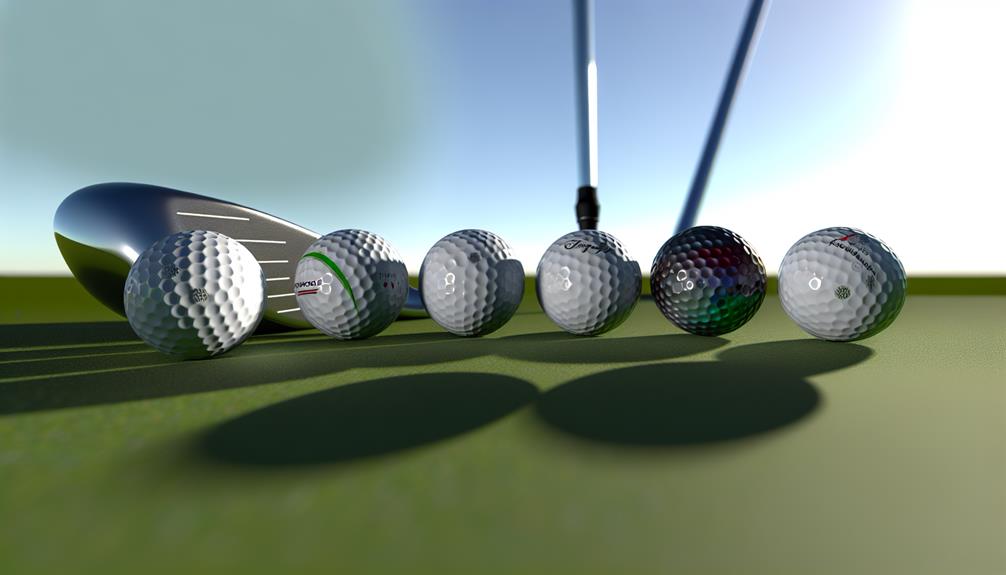Did you know that nearly 40% of your golf strokes are putts? You're probably working tirelessly on your swing, but it's clear that honing your putting skills can significantly improve your overall game.
The type of ball you use for putting practice can profoundly affect your performance. So, what are the top golf balls for putting practice, and how do they enhance your precision and control?
Stick around, and you'll find out why the right ball could be your secret weapon on the green.
Evaluating Golf Ball Characteristics
When it comes to picking the right golf ball for your putting practice, you'll need to carefully evaluate the ball's characteristics such as its construction, spin, feel, and durability. Let's delve deeper into these aspects, particularly focusing on golf ball durability and ball material analysis.
Golf ball durability is a crucial factor. You don't want your balls deteriorating after a few hits. Some balls, like urethane-covered ones, excel in durability. They resist scuffs and cuts, lasting longer. However, their feel mightn't be as soft as other materials. It's a trade-off you need to consider.
Ball material analysis is another consideration. Balls are typically constructed with one to five layers, each influencing the ball's performance differently. A one-piece ball, often of solid Surlyn, is durable but not very responsive. Contrastingly, multi-layered balls, like three-piece balls, offer more control and spin but may be less durable.
When evaluating, pay attention to the hardness or softness of the ball. Harder balls may last longer but could compromise on control and feel. So, balance durability with performance characteristics to pick the perfect ball for your putting practice.
Top 5 Golf Balls for Putting
Now that we've assessed the key considerations, let's delve into the top five golf balls that'll give your putting practice a significant boost.
First off, the Titleist Pro V1 is known for its impressive branding impact and exceptional performance. It's designed for consistency and accuracy, two factors that significantly enhance your putting.
The Callaway Chrome Soft comes a close second. It's engineered for optimal control, boosting your confidence on the green. The cost comparison between the Pro V1 and Chrome Soft reveals that the latter offers similar quality at a lower price point.
The TaylorMade TP5 offers five-layer construction for improved spin control, whereas the Bridgestone Tour B330-RXS stands out with its urethane cover for increased feel and control.
Impact of Ball Design on Putting
Understanding the design of a golf ball can significantly improve your putting skills, as each element of the ball's construction, from the type of cover to the number of layers, can impact its performance on the green.
The ball's cover texture, for instance, plays a crucial role in surface interaction effects. A smoother surface reduces air resistance, allowing the ball to roll further, while a textured surface enhances grip, promoting more controlled putts.
Ball rotation dynamics also come into play. The ball's core and layer structure influence its rotation, affecting how it reacts to your putt's speed and direction. A multi-layer ball, for instance, often provides better spin control and a softer feel, leading to more precise putts.
The dimple pattern, too, is instrumental in determining the ball's flight and roll. A well-designed pattern can lessen air resistance and increase lift, improving the ball's stability and distance.
Specialty Putting Practice Balls
While the design elements of golf balls significantly affect your putting performance, specialty putting practice balls are specifically engineered to help you master the art of putting. These balls are designed to provide immediate feedback on your stroke and rotation, making them an invaluable tool for sharpening your putting techniques.
One major advantage of these balls is their suitability for indoor practice. They're typically lighter and smaller than traditional golf balls, reducing the risk of damage to your home or office. You can easily practice your putting techniques regardless of weather conditions or time constraints, enhancing your convenience and flexibility.
Specialty putting practice balls often feature unique markings. These markings can help you visualize the ball's path and determine the impact of your stroke on the ball's rotation and direction. For example, if you're hitting the ball off-center, the markings will wobble, indicating a need for stroke adjustment.
In essence, specialty putting practice balls serve as a diagnostic tool to identify and improve your putting flaws. They offer a practical and effective approach to mastering the art of putting, making them a worthy investment for any golf enthusiast looking to elevate their game.
User Reviews and Feedback
Delving into user reviews and feedback, you'll find invaluable insights from golfers who've tested and rated various specialty putting practice balls. These insights provide a wealth of detail, offering an understanding of user satisfaction levels and perspectives that a simple product description can't deliver.
From feedback analysis, it's evident that golfers value consistency in their putting practice balls. They appreciate balls that mimic the feel and roll of a standard golf ball on the green. Several reviews praise the balls that produce a true roll, allowing them to accurately gauge their putting strength and direction.
Conversely, there's dissatisfaction expressed with balls that are too light, too hard, or have an unpredictable roll. These shortcomings hinder the effectiveness of the practice session and, consequently, reduce user satisfaction.
There's also a clear preference for durability. Golfers want putting practice balls that can endure heavy use without losing their shape or performance characteristics.

